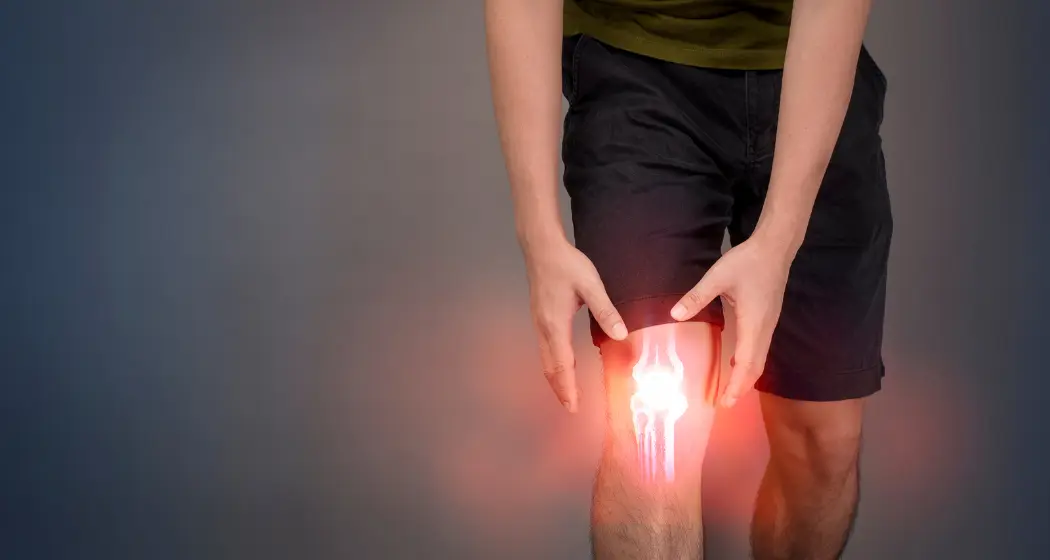Knee pain when leg is straight can be a debilitating condition, particularly when the knee joint is under strain, causing bend knee pain. Knee pain on squats can exacerbate this discomfort. Understanding the root reasons behind knee pain and learning various soothing strategies can greatly enhance quality of life. This article explores why proper alignment matters, stretching techniques, natural remedies, and knowing when to seek professional help. It aims to provide readers with effective methods to alleviate knee pain and strengthen the supporting structures around the knee joint.
Key Takeaways
- A seated quadriceps stretch can target the front thigh muscles effectively, offering relief for knee pain when leg is straight.
- Incorporating stretches for the quadriceps, hamstrings, calves, and IT bands is crucial, but must be done with proper technique to avoid injury.
- Starting stretches slowly and using gravity to relax the thigh can prevent undue stress on the knee and lower back.
- A combination of soft tissue manipulation, stretching, ergonomic changes, and topical analgesics can provide comprehensive knee pain management.
- Persistent knee pain should prompt a visit to the doctor, as professional diagnosis and treatment are essential for chronic or worsening conditions.
Understanding Knee Pain and the Importance of Proper Alignment
It’s essential to recognize that knee pain is not a singular issue but a symptom that may arise from various underlying conditions. Addressing these factors holistically is key to effective management and relief.
Identifying the Causes of Knee Pain
Knee pain can arise from many different sources, each requiring a unique approach to treatment. Knowing the knee joint’s anatomy helps identify discomfort causes precisely. Osteoarthritis, for instance, is a common culprit, especially in individuals over 50, with research indicating that up to 70% of chronic knee pain sufferers show signs of this condition on radiographs.
The factors contributing to knee pain are numerous and often interrelated:
- Aging and natural wear and tear
- Sedentary lifestyle and weakened supporting muscles
- Repetitive stress and high-impact activities
The prevalence of knee pain is further compounded by factors such as aging, sedentary lifestyles, and repetitive stress on the joints.
The Role of Leg Alignment in Knee Health
Proper leg alignment is essential for maintaining knee health and function. Alignment, referring to the positioning of bones like hips, knees, ankles, and feet, plays a vital role in distributing weight and stress across joints. When alignment is off, it can lead to uneven pressure on the knee, which may cause pain and increase the risk of injury.
Maintaining optimal leg alignment is not only crucial for preventing knee pain but also for ensuring the longevity of joint health.
Here are some key points to think about concerning leg alignment and knee health:
- Proper alignment helps in evenly distributing forces across the knee joint.
- Misalignment can result in increased stress on certain parts of the knee, leading to pain and degeneration.
- Regular assessment of leg alignment can help detect potential issues early on.
- Corrective exercises and stretches can improve alignment and reduce the risk of knee pain.
Preventing Knee Pain with Correct Posture
Maintaining correct posture is essential in preventing knee pain, especially when the leg is straight. Proper alignment of the leg, from the hip to the ankle, ensures balanced distribution of weight and reduces stress on the knee joint.
- Maintain a straight back and avoid slouching to prevent leg misalignment.
- Activate your core muscles to stabilize and support your lower back.
- Ensure even weight distribution on both feet while standing
- Be mindful of your sitting position, especially if you spend long hours at a desk.
By focusing on correct posture, you can minimize the strain on your knees and promote long-term joint health.
It’s important to start off carefully and slowly to protect your lower back and knee. Allow gravity to assist in maintaining a relaxed thigh position, which can help in preventing tightness in the hip flexors and rectus femoris, ultimately contributing to better knee health.
Stretching Techniques for Alleviating Knee Pain
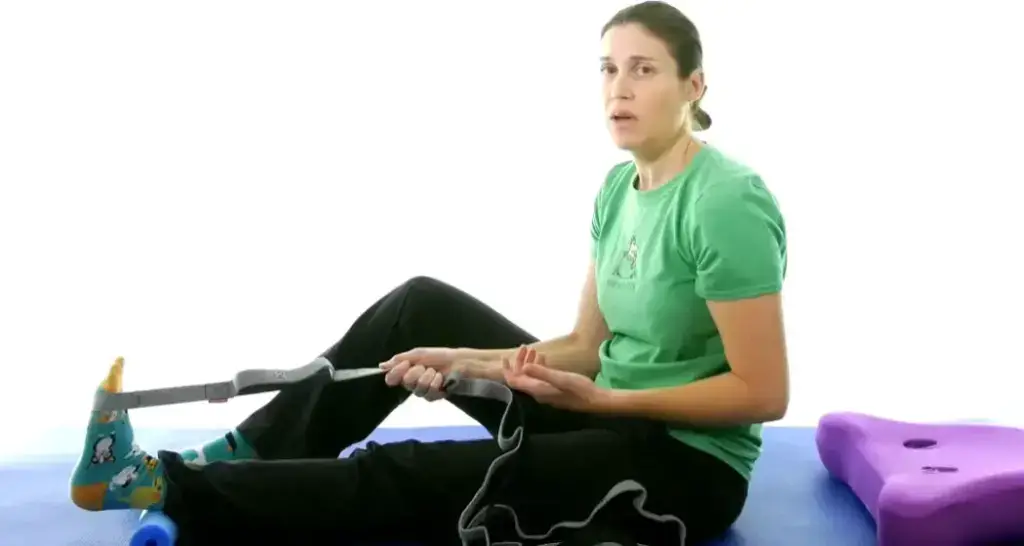
Seated Quadriceps Stretch for Knee Relief
The Seated Quadriceps Stretch is a gentle yet effective way to alleviate knee pain when leg is straight. This stretch targets the front thigh muscles, which are crucial for knee stability and mobility.
To perform this stretch:
- Gently guide the bent knee, Sit on the floor with your legs stretched out.
- Bend one knee, bringing the foot toward your buttocks.
- Gently guide the bent knee towards the floor.
- Hold for 15-30 seconds, then switch legs.
If performed correctly, you should feel your quadriceps stretching without pain in your knee, hip, or lower back.
Remember to engage your glutes during the stretch, as inactive gluteal muscles can lead to tight quadriceps. Incorporating this stretch into your routine can prime your body for physical activities and aid in recovery.
Incorporating Hamstring and Calf Stretches
To effectively manage knee pain, it’s crucial to include stretches that target both the hamstrings and calves. These muscle groups are crucial for supporting knee stability and mobility. A well-rounded stretching routine can help alleviate tension and improve flexibility in these areas, contributing to overall knee health.
For the hamstrings, a simple yet effective option is the Standing Hamstring Stretch. Hinge at your hips, then Stand with your feet shoulder-width apart, and lean forward, reaching toward your toes. Make sure your back stays straight and your core muscles are engaged. Hold this position for 15-30 seconds to feel the stretch in your hamstrings. If balance is a concern, you can perform a similar stretch while seated.
When it comes to the calves, the Towel Calf Stretch is a gentle and controlled method. Sit with your legs extended, place a towel around the ball of one foot, pull it gently toward you, ensuring the knee stays straight. Hold for 15-30 seconds before switching legs.
Remember, stretching should be done with care to avoid exacerbating knee pain. Always prioritize proper technique and avoid overstretching, as this can lead to further injury.
The Significance of IT Band Flexibility
The iliotibial (IT) band, a thick band of connective tissue that extends along the outside of your leg, extending from your hip to your knee, plays a crucial role in knee stability, especially during high demand activities such as sports and running. Maintaining flexibility in the IT band is essential for preventing knee and joint injuries.
Proper stretching of the IT band can alleviate tightness and improve joint mobility. A popular method is the side-lying IT band stretch, which targets the outer thigh and hip. It’s important to hold the stretch for an adequate duration, typically 15-30 seconds, to effectively elongate the muscles and connective tissues.
Consistent stretching of the IT band, along with strengthening of surrounding muscles, can significantly reduce the risk of ITB syndrome, characterized by inflammation and pain around the outer knee area.
Treatment for ITB syndrome often includes a combination of rest, targeted strengthening, and ensuring proper hip mobility. Heat may also be applied for pain relief. By addressing IT band flexibility, individuals can support their knee health and prevent the onset of related issues.
Stretching Safely to Avoid Further Injury
When it comes to alleviating knee pain, stretching is a vital component of self-care. However, it’s crucial to stretch in a manner that prevents further injury. Starting with gentle static stretches is recommended, as they allow the muscle to extend without movement, minimizing the risk of overextension. Dynamic stretches should follow, which involve controlled movements that warm up the muscles effectively.
- Static Stretches: Holding each stretch for 30-4- seconds, repeating several times daily.
- Dynamic Stretches: Perform controlled movements to prepare muscles for activity.
It’s essential to protect your back and maintain a neutral pelvis position during these exercises. This approach helps in avoiding strain on the lower back and keeps the focus remains on the knee. Remember, only stretch as far as your body comfortably allows; pushing beyond your limits can lead to setbacks rather than progress.
To truly benefit from stretching, ensure that your posture is correct before you begin. This means keeping your back straight and pelvis neutral, which is fundamental in preventing additional strain on your knee and back.
Comparing Stretching Positions: Standing vs. Seated
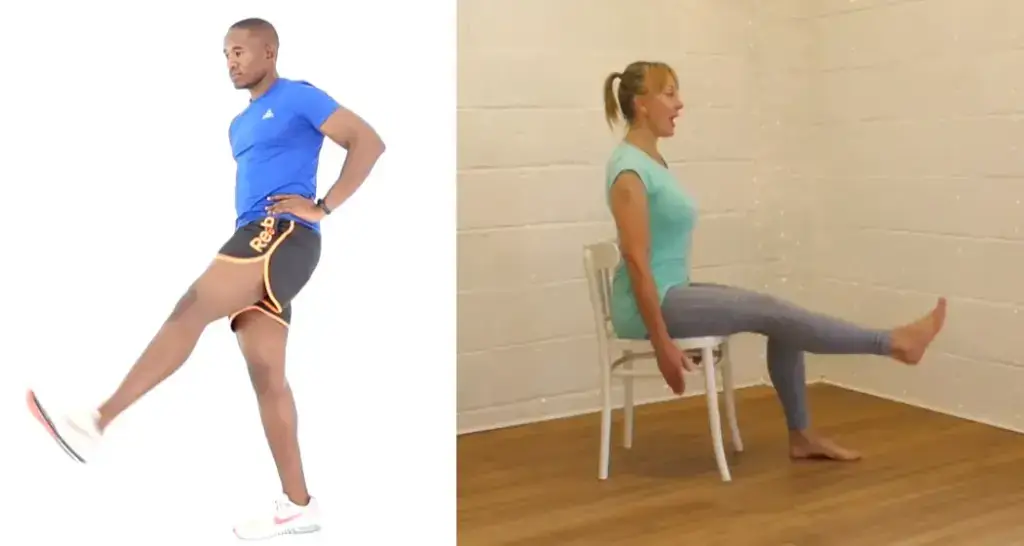
Benefits of Standing Stretches for Knee Pain
Standing stretches for knee pain are a cornerstone of many rehabilitation programs. Standing positions can help to improve balance and stability, which are crucial for knee joint health. When you perform stretches while standing, you engage more muscle groups, particularly those that support the knee joint, leading to a more comprehensive strengthening effect.
- Engages more muscles: Standing stretches involve multiple muscle groups, enhancing overall stability.
- Improves balance: Balance is essential for knee health, and standing stretches can help to develop it.
- Encourages proper form: It’s easier to maintain proper alignment while standing, reducing the risk of injury.
If you have pre-existing knee conditions or concerns, It’s wise to seek help from a healthcare professional or physical therapist. Integrating standing stretches into your daily routine can offer a straightforward yet effective method to enhance joint health. These exercises, as part of a holistic knee care plan, can provide support and alleviate pain.
When to Opt for Seated or Lying Stretches
Choosing between standing and seated or lying stretches often depends on your environment and specific needs. Seated and lying stretches are ideal when you have access to a comfortable surface and require more stability. These stretches are especially advantageous for individuals dealing with balance issues or recuperating from an injury.
Seated stretches like the Seated Lunge can be conveniently done at work or home, targeting tight quads and hip flexors without the need for extensive space or equipment.
Lying stretches offer a stable platform for maintaining proper alignment, thereby lowering the risk of additional injury. Here are some seated and lying stretches that can be incorporated into your routine:
- Seated short groin stretch: Helps to open the inner thighs and can be done easily on the floor.
- Seated long groin stretch: Extends the legs to the sides, increasing flexibility in the groin area.
- Lunge while seated: Specifically targets the quads and hip flexors, and can be done while seated at a desk.
Remember, it’s important to listen to your body and choose stretches that do not exacerbate your knee pain. If you experience discomfort, consider modifying the stretch or consulting a professional.
How to Choose the Right Stretching Surface
Choosing the right surface for stretching is crucial for comfort and to prevent further injury. Adequate padding is essential to cushion the joints and provide stability during stretches. Whether you opt for a slant board, a yoga mat, or the softness of your couch, ensure the surface supports your body without causing additional strain.
- Slant boards are often recommended by experts for their adjustable angles, aiding in the effectiveness of stretches. For instance, the Strong Tek Professional Wooden Slant Board is a top pick for its versatility.
- Yoga mats offer a portable and cushioned option, suitable for a variety of stretches.
- Home furniture like a couch or bed can also serve as a stretching surface, provided they offer sufficient padding for the knees.
Remember, the goal is to enhance the stretch, not to endure discomfort from the surface you’re using. Listen to your body and adjust your choice accordingly.
When stretching on the go, a flat and stable surface such as a park bench or even firm ground can suffice. The crucial aspect is to uphold proper alignment and posture to optimize the benefits of your stretching regimen.
Natural Remedies and Treatments for Knee Pain
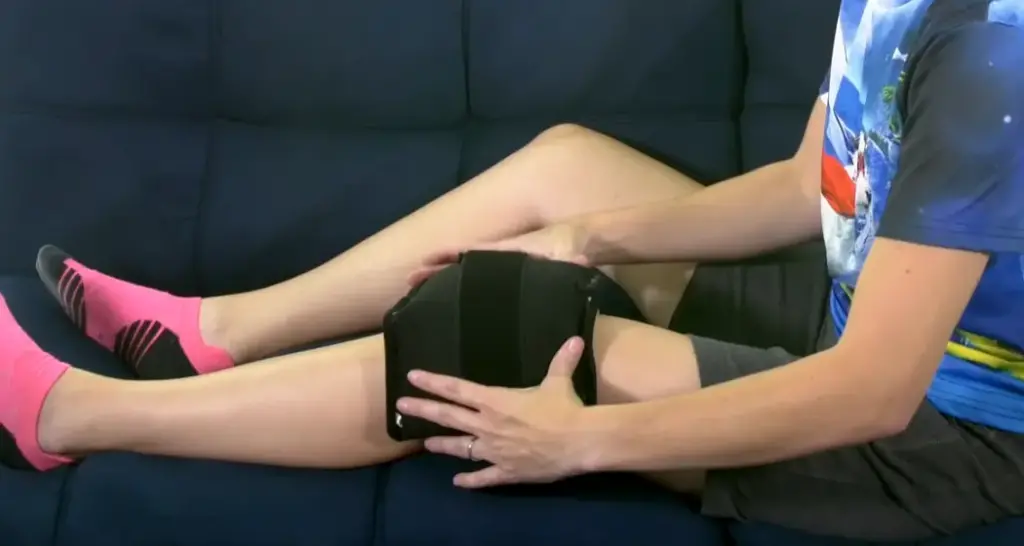
Soft Tissue Manipulation and Trigger Point Therapy
Soft tissue manipulation and trigger point therapy are hands-on techniques used to alleviate knee pain by addressing the underlying muscle and connective tissue problems. These therapies target muscle tension and aim to alleviate knots in the muscles, which can contribute to knee pain when the leg is straight.
By applying pressure to specific points on the body, known as trigger points, therapists can release tension and enhance blood flow, this targeted approach to the affected area leads to decreased pain and enhanced mobility.
The following is a list of common conditions that may benefit from soft tissue manipulation and trigger point therapy:
- Patellofemoral Pain Syndrome (PFPS)
- IT Band Syndrome
- Lower Back Pain – Disc Herniation
- Neck Pain & Aches
- Thoracic Outlet Syndrome
It’s crucial to highlight that while these therapies can yield positive results, they should be administered by a trained professional to guarantee safety and achieve the best results.
The RICE Method: A First Response to Knee Injury
The RICE method is a widely recognized first aid response for acute knee injuries. Rest is crucial to prevent further damage and allow the healing process to begin. Use ice to decrease the swelling and alleviate pain. Compression with bandages can help minimize inflammation, and Elevation of the injured leg above heart level aids in decreasing swelling.
- Rest: Do not place weight on the injured knee.
- Ice: Apply cold packs for 20 minutes every 2 hours.
- Compression: Use elastic bandages to wrap the knee snugly.
- Elevation: Prop the leg up on pillows to keep it raised.
The RICE method offers a straightforward yet effective way to manage minor knee injuries at home. It’s essential to follow these steps promptly to mitigate pain and swelling.
If the pain persists or is severe enough that cold therapy doesn’t provide relief, over-the-counter NSAIDs may be advised to help alleviate pain and inflammation. After the initial phase, some individuals find therapeutic heat beneficial for loosening stiff muscles and improving mobility.
Topical Analgesics: Understanding Their Efficacy
Topical analgesics are a convenient option for those seeking immediate, localized relief from knee pain. These treatments, including gels, creams, sprays, and patches, are formulated to penetrate the skin and directly target the knee joint. They can be particularly effective in reducing inflammation and providing temporary pain relief.
While topical analgesics can offer quick relief, it’s important to remember that they are not a cure for underlying conditions. Consistent use can help manage symptoms, but should be part of a broader treatment strategy.
When considering topical analgesics, it’s crucial to understand their active ingredients and potential side effects. Here’s a brief overview:
- NSAIDs: Nonsteroidal anti-inflammatory drugs, such as ibuprofen, reduce inflammation and pain.
- Capsaicin: Derived from chili peppers, it works by decreasing the intensity of pain signals.
- Lidocaine: An anesthetic that numbs the area, providing pain relief.
- Salicylates: Related to aspirin, they help reduce pain and inflammation.
If knee pain persists or worsens, it’s advisable to consult a doctor. They can assess the pain and may prescribe additional medications or recommend alternative treatments such as physiotherapy, acupuncture, or massage therapy.
Knowing When to Seek Professional Help
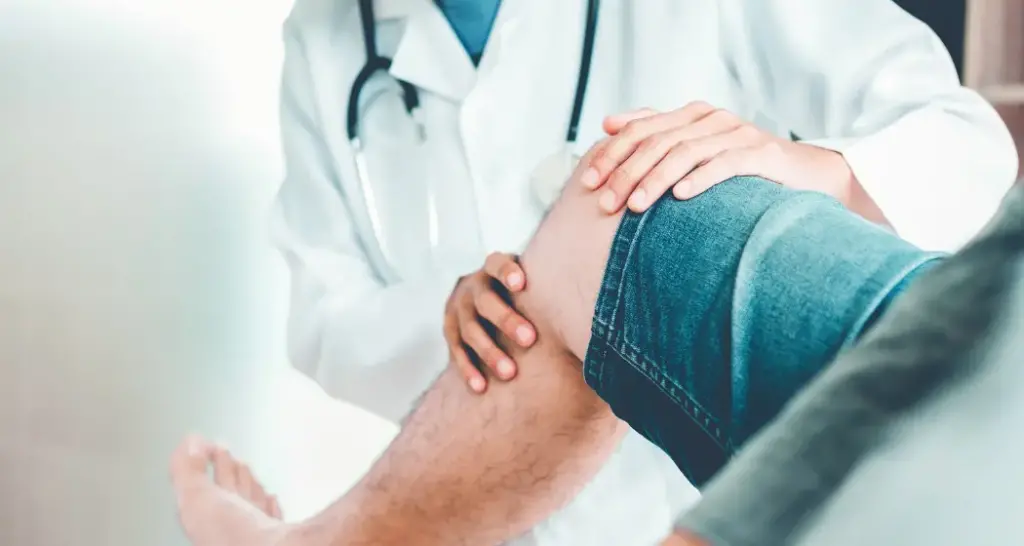
Recognizing Persistent Pain as a Sign to See a Doctor
Persistent knee pain can indicate the need to consult a healthcare professional. If your knee pain continues despite rest and home remedies, or if it interferes with your daily activities, seeking medical advice is crucial. Knee pain that persists for more than a few weeks can signal underlying issues that require professional diagnosis and treatment.
It’s important to be aware of certain symptoms that necessitate immediate medical attention. For example, if after an injury your knee pops, is bent or deformed, or you feel extreme pain, it’s imperative to head to the ER as soon as possible. These symptoms may indicate a severe injury requiring urgent medical attention.
While occasional knee discomfort may not be cause for alarm, consistent or severe pain should never be ignored. Early intervention can prevent further damage and lead to more effective management of your condition.
How Professional Diagnosis Can Guide Effective Treatment
A professional diagnosis is pivotal in crafting a personalized treatment plan designed to meet the unique needs of your knee condition. Understanding the root cause of your pain, a healthcare provider can recommend targeted therapies that are more likely to result in long-term relief. For instance, a diagnosis of knee bursitis would lead to a tailored approach that may include rest, medication, and physical therapy.
- A comprehensive physical examination and thorough medical history are essential initial steps in the diagnostic process.
- Treatment plans may involve a combination of rest, medication, physical therapy, and sometimes surgery.
- Follow-up care is crucial to monitor progress and adjust treatment as necessary.
Adhering to the treatment plan prescribed by your healthcare professional is essential to achieve the best possible outcome. This often includes a combination of therapies and may require patience and persistence.
Remember, each individual’s path to recovery is unique, and what works for one person may not work for another. Your healthcare provider’s expertise in diagnosis can lead to a more effective and personalized treatment strategy.
Integrating Medical Advice with Home Care Strategies
After consulting with healthcare professionals, it’s crucial to integrate their advice into your daily routine to manage knee pain effectively. Incorporating expert recommendations with home care strategies can enhance your recovery process and ensure consistency in treatment. Here are some practical steps to blend medical guidance with home remedies:
- Follow prescribed medication schedules, and consider setting alarms as reminders.
- Maintain an active lifestyle, as recommended by your doctor, to help reduce pain and stiffness.
- Utilize assistive devices or home equipment suggested by occupational therapists to ease daily tasks.
- Reach out for support when needed, through helplines or online communities.
Keep in mind, the objective is to create a synergistic approach that combines professional healthcare with effective home management techniques. By taking a proactive role in your treatment, you can effectively manage symptoms and enhance your quality of life. It’s also important to stay informed about new and innovative therapies that may complement your current regimen.
Conclusion
In summary, managing knee pain when the leg is straight involves a combination of gentle stretches, proper technique, and mindful practices. The seated quadriceps stretch is a key exercise that can be performed on various surfaces, providing flexibility in your routine. It’s crucial to start slowly, using gravity to assist in the stretch without exerting undue force that could exacerbate pain. The RICE method remains a cornerstone for initial pain management, while topical analgesics can offer additional relief. Remember, if knee pain persists or worsens, consulting a healthcare professional is essential. By integrating these soothing strategies into your daily life, you can work towards alleviating knee pain and improving joint health.
Frequently Asked Questions
What is the best stretch for knee pain when leg is straight?
A seated quadriceps stretch is highly effective for knee pain relief when your leg is straight. Sit with legs extended, bend one knee and gently press it toward the floor to stretch the quadriceps of the extended leg. Hold for 15-30 seconds and repeat on the other leg.
How can I safely stretch to avoid further knee injury?
Start stretching carefully and slowly to protect your back and knee. Allow gravity to help and avoid pulling forcefully on your foot. Ensure you’re on a comfortable surface with sufficient padding to prevent overexerting your knee.
What are the benefits of standing stretches compared to seated or lying stretches for knee pain?
Standing stretches can be beneficial for knee pain as they allow for a full range of motion and natural alignment. However, seated or lying stretches can be equally effective, especially when done on a padded surface like a couch or bed to protect the knee.
What should I do if I experience knee pain with symptoms like swelling or muscle weakness?
If you experience knee pain along with swelling, muscle weakness, or difficulty moving, use the RICE method: Rest, Ice, Compression, and Elevation. If the pain persists, seek medical advice.
Can natural remedies and treatments be combined for knee pain relief?
Yes, combining treatments such as soft tissue manipulation, stretching, chiropractic adjustments, acupuncture, massage therapy, and ergonomic changes can help alleviate knee pain.
When should I see a doctor for knee pain?
You should consult a doctor immediately if your knee pain does not subside, worsens, or interferes with your daily activities. A professional diagnosis can guide effective treatment and prevent further complications. At Waters Edge Medical Clinic we specialize in knee pain treatments. We are a natural pain and regenerative medicine clinic, our goal is to not only relieve your knee pain but to also help regenerate the affected tissue. If you are suffering with knee pain, look no further and schedule a free consultation and evaluation with us. Our office location is Waters Edge Medical Clinic and Spa. 1700 66th St. N. Suite 304, St. Petersburg, Fl. 33710. Our office number is 727-550-0855.

